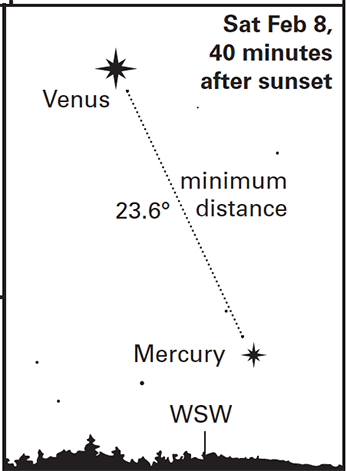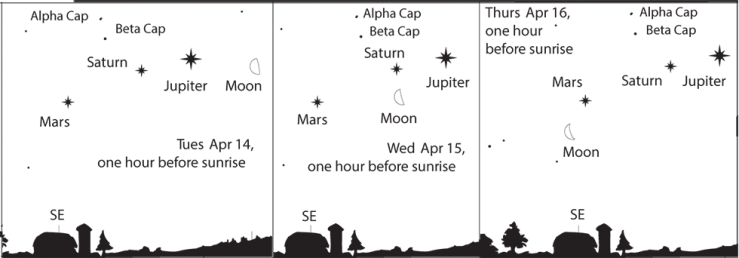Moon, Planets, and Stars, February through April 2020
By Robert C. Victor
In the western sky at dusk, Mercury in February, and Venus in March-April, reach their highest positions and best visibility of 2020. In the predawn darkness of February 18, the Moon covers and uncovers Mars (timetable provided). All three bright outer planets, Mars, Jupiter, and Saturn, are visible in SE before dawn these months. Don’t miss their rare, once-in-20 years compact gathering in late March! In mid-March, Mercury reaches its highest position of a poor morning twilight appearance very low in ESE. Binoculars will help you find the innermost planet well to lower left of the outer planet threesome.
February 2020
February evening sky map for Southern California | February evening sky map for Northern California
You’ll certainly notice brilliant Venus well up in WSW to W at dusk, with Mercury to its lower right until it fades soon after mid-month. Mercury shines at mag. –1 on February 1, fading to mag. 0 on February 13, to mag. +1 by February 17 and very rapidly thereafter. Mercury lingers 24° from Venus February 4-11. The revolution of the planets is counterclockwise around the Sun, as viewed from above the northern side of the solar system. Fast-moving Mercury and Venus are gaining on Earth and coming around from the far side to the near side of the Sun. This causes Mercury, but not cloud-covered Venus, to fade as the planet goes through crescent phases. Mercury appears at greatest elongation, 18° from Sun, on February 10.
Sirius, the Dog Star, twinkles vigorously in SE. It is the lowest and brightest member of the huge Winter Hexagon of stars of first magnitude or brighter. In clockwise order, they are Sirius, Procyon, Pollux (with fainter twin Castor just 4.5° away),

Capella nearly overhead, Aldebaran, Rigel, and back to Sirius. Betelgeuse is normally the brightest star inside the boundaries of the Hexagon, but something has happened to this star! At the time of this writing in January, Betelgeuse appears barely as bright as Bellatrix, the other shoulder of Orion. Keep an eye on Betelgeuse, comparing it to other stars of known brightness. Refer to the resources at the end of this article.
Other bright stars in February at dusk include Deneb, last star of the Summer Triangle to slip away in the NW, and Regulus, heart of Leo, at opposition to the Sun on February 18.
February morning sky map for Southern California
February morning sky map for Northern California
Jupiter is the brightest morning “star”, with Mars to its upper right, and Saturn emerging early in February, to Jupiter’s lower left. Ranking next after Jupiter in brightness are golden Arcturus high in SW, and blue-white Vega high in ENE to E. Look for Spica in SW far below Arcturus, Regulus sinking in W to WNW, reddish Antares, heart of the Scorpion in the S, and the stars Altair and Deneb completing the Summer Triangle in the eastern sky. By observing the sky at dawn in February, we can get a “sneak preview” of the stars in positions we’ll see them at dusk in July. Jupiter and Saturn will also be seen in the southeast sky at dusk in July, but fast-moving Mars will have moved on and rise late at night in July, or at dusk not until September-October.

February 18-20: Moon and three bright outer planets
For three consecutive mornings, February 18-20, the waning crescent Moon appears close to a different member of the three bright outer planets. In fact, on February 18, during some part of the predawn, the Moon actually occults (covers) Mars. It’s the bright leading edge of the Moon that covers Mars (so optical aid will be needed). Within an hour later, Mars reappears at the dark edge of the Moon. From northern California, the Moon rises with Mars already covered. Here are times for a selection of California cities; a blank line ––– indicates that Mars is already hidden as the Moon rises.
| City | Disappearance | Reappearance |
| Palm Springs | 3:36 am | 4:30 am |
| Los Angeles | 3:37 am | 4:27 am |
| San Diego | 3:38 am | 4:26 am |
| Bakersfield | 3:35am | 4:29am |
| San Francisco | ---------- | 4:29 am |
| Sacramento | ---------- | 4:32am |
Note the disappearance of Mars occurs very low in the sky, ranging from 7° up in extreme southeastern California, to only 2° up in Bakersfield. Watch out for mountains and other obstructions!

On February 19, the Moon is close to Jupiter, and on February 20, close to Saturn, as shown in the diagram above.
These are wide pairings of the crescent Moon and Venus. You can also look just before sunset for Venus in daylight, 10° upper right of Moon on February 26, and 6°-7° lower right of Moon on February 27.
March 2020
March evening sky map for Southern California | March evening sky map for Northern California
The Winter Hexagon is in fine view, with Sirius, the brightest star, crossing through south, and Capella, its second brightest member, passing N of overhead for all of California. Check on Betelgeuse inside the Hexagon. Has it regained some of its brilliance since you started monitoring it? In early March, sky watchers in southernmost California can still catch Canopus passing due south, very low, about 22 minutes before Sirius does. Venus far outshines all these stars, and climbs to its highest near the date of greatest elongation, March 24. Telescope shows Venus’ phase, then half full. Crescent Moon skips past Venus March 27-28, passing widely south of the planet. Catch the Pleiades star cluster within 5° of Venus for eleven evenings, March 29-April 8. Binoculars give stunning views!
March morning sky map for Southern California | March morning sky map for Northern California
Bright Jupiter attracts our attention to the southeast, where the three bright outer planets span 18.5° on March 1, closing to 6.3° at month’s end. Can you spot Mercury in the twilight glow to their lower left? Binoculars help. Early risers will be well rewarded by the rare morning scenes depicted on the excerpt from the March 2020 Sky Calendar, below. Be sure to catch the compact gathering of Moon and three planets within a span of 8.3° on March 18, and the same three planets spanning just 7.1° to 6.3° during March 20-31, as Mars, in the foreground, passes from Jupiter toward Saturn. Watch Mars pass 0.7° S of Jupiter on March 20, and 0.9° S of Saturn on March 31. Scenes for many individual dates are depicted on this excerpt from the March Sky Calendar.

March 18-31 Sky Calendar | Right click to view image in a larger format
April 2020
April evening sky map for Southern California | April evening sky map for Northern California
Going eastward against the background stars of Taurus at a decreasing pace, Venus loses altitude late in the month, as its eastward motion against the stars fails to keep up with the Sun’s. Venus attains peak brilliance in crescent phase in late

April. Winter’s bright stars have moved into the western sky, and most will exit during May. Regulus, heart of Leo, climbs high in the south, and golden Arcturus ascends in E to ENE. To Arcturus’ lower right at dusk, blue-white Spica stands at opposition to the Sun on April 13 and is visible almost all night.
Binoculars give stunning nightly views! Two days before the very close pairing of Venus with 3rd-mag. Alcyone, or Eta Tauri, the brightest star of the Pleiades, they’re within 1.8°. They’ll be less than 0.3° apart on April 3. Binoculars will certainly come in handy for observing the close conjunction!

Venus is now moving east against background stars by about 0.9° per day, pulling away from the Pleiades. This evening, Venus and Alcyone are 1.9° apart.
April morning sky map for Southern California
April morning sky map for Northern California
The gap between Jupiter and Saturn is 6° on April 6, closing to 5° by April 28. Mars moves rapidly east against background stars, increasing its distance east of Saturn from 1.0° on April 1 to 20° on May 1. Stars on April mornings are in locations similar to where we’ll find them in late August and early September at dusk: Summer Triangle approaching overhead, Arcturus in west, , Antares in SW, and Spica setting in WSW.


Moon goes from 6° west of Jupiter to nearly 5° east of Mars.
At sunset, find Venus about 7° to the right of the 15-percent crescent Moon and a little lower. Venus is itself a crescent, 28 percent full and 37 arcseconds across, large enough to detect its shape with a steadily held pair of binoculars. The most fascinating views of Venus, both in daytime and at dusk, are yet to come, in May.
Illustrations by Jeffrey Hunt:
Planet setting times in evening for Southern California for School Year 2019-2020
Planet setting times in evening for Northern California for School Year 2019-2020
These two graphs show favorable evening opportunities for viewing Mercury in January-February and again in May-June 2020. Also shown is that Venus will be visible longest after sunset in late March 2020. In late May, as Venus approaches inferior conjunction with the Sun, its setting time rapidly shifts earlier, toward the time of sunset.
Illustrations by Jeffrey Hunt:
Planet rising times in morning for Southern California for School Year 2019-2020
Planet rising times in morning for Northern California for School Year 2019-2020
These graphs show Mars, Jupiter, and Saturn all rising around the same time, about three hours before sunrise in late March 2020. Also in March, around mid-month, Mercury rises a maximum time interval before the Sun, but in bright twilight, not long before sunrise. So the March morning apparition of Mercury is less favorable for viewing, compared to the ones about four months before and after. After Venus’ inferior conjunction and passage between Earth and Sun on June 3, Venus quickly rises well before sunrise, until in late August it comes up well over three hours before sunup.
Illustrations by Robert D. Miller - evening and morning twilight sky maps embedded in article.




